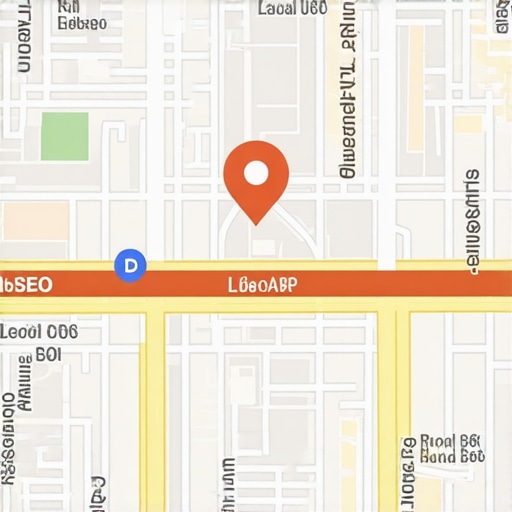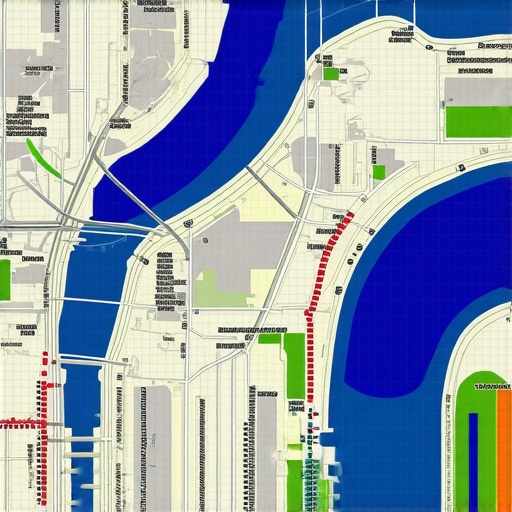Unlocking the Power of Maps SEO: A Deep Dive into Search Visibility Enhancement
In the competitive landscape of local search, optimizing for Google Maps SEO is not merely an option but a necessity for businesses seeking increased visibility and higher rankings. As digital algorithms evolve, understanding the nuanced layers of Maps SEO becomes essential for industry professionals committed to maintaining a competitive edge. This article explores advanced strategies rooted in data-driven insights and expert methodologies to amplify your local search prominence in 2024.
How Do Search Engine Algorithms Interpret Map-Based Local Signals?
Google’s understanding of local intent hinges on a sophisticated interpretation of proximity, relevance, and prominence. These signals are further refined by the incorporation of user-generated content, behavioral analytics, and authoritative link profiles. Leveraging structured data markup, such as Schema.org LocalBusiness schema, allows for a more explicit communication of your business attributes, which search engines interpret with greater accuracy. For comprehensive insights, consult the white paper on search engine algorithms and local signals.
Key Technical Optimization Tactics for Maps SEO Mastery
Technical SEO remains foundational—ensuring your Google My Business (GMB) profile is fully optimized with accurate NAP (Name, Address, Phone Number) details, categories, and service descriptions. Beyond basic setup, implementing advanced local schema markup enhances search engine comprehension. Additionally, optimizing your website’s load speed, mobile responsiveness, and user experience directly influence local ranking signals. Regularly auditing your citations and backlinks from authoritative local sources consolidates your local authority, critical for competitive rankings.
Can User Engagement Metrics Significantly Impact Map Rankings?
Indeed, user engagement metrics such as click-through rates, review quality, and behavioral signals like dwell time directly influence local search rankings. Encouraging satisfied customers to leave detailed reviews improves reputation signals and enhances visibility. Employing tools like Google Review Link generators and integrating review prompts on your website can cultivate an active review ecosystem. High-quality interactions foster trust and signal relevance, pivotal in a hyper-competitive environment.
Strategic Content Approaches for Sustainable Visibility
Content is a cornerstone of Maps SEO. Developing locally relevant, authoritative content that addresses niche-specific queries can elevate your prominence. Incorporate LSI keywords such as “local business optimization,” “Google Maps ranking techniques,” and “local SEO best practices” into your content to broaden semantic reach. Furthermore, creating location-specific landing pages and leveraging user-generated content can serve as powerful signals to search engines.
What Are the Most Overlooked Factors that Can Sabotage Your Maps SEO Efforts?
Many professionals overlook the importance of consistency in citations, the impact of duplicate listings, and the significance of active profile management. Neglecting to monitor and respond to reviews or failing to update business information promptly can erode your local authority. Additionally, ignoring mobile optimization or failing to utilize structured data can severely hinder your rankings. Regular audits and proactive profile management are essential in preempting these pitfalls.
For those eager to deepen their understanding, exploring comprehensive guides such as the Ultimate Maps SEO Guide can provide invaluable insights. To contribute your expertise or share innovative strategies, engaging with community forums or professional networks can foster further growth.
Harnessing the Power of Local Data Analytics for Maps SEO
One of the most underestimated aspects of Maps SEO is the potential of local data analytics. By leveraging tools like Google Analytics and Search Console, businesses can gain nuanced insights into user behavior, search patterns, and engagement metrics specific to their geographic area. Analyzing this data helps identify gaps in visibility and refine local SEO strategies effectively. For example, understanding which search queries lead users to your profile allows for targeted keyword optimization, such as incorporating long-tail keywords like “best Italian restaurant downtown” to capture niche traffic. To deepen your understanding, explore expert insights on effective Maps SEO techniques for 2024.
Can Geospatial Machine Learning Revolutionize Your Local Search Strategy?
Emerging technologies like geospatial machine learning are poised to transform how businesses approach local search optimization. These advanced algorithms analyze vast amounts of location-based data, behavioral patterns, and environmental factors to predict user intent and personalize search results dynamically. By integrating geospatial AI tools into your SEO workflow, you can anticipate shifts in local demand, optimize your content proactively, and prioritize high-impact areas for your marketing efforts. For instance, predictive analytics can suggest optimal times for launching local campaigns or updating your Google My Business profile to align with seasonal trends. As industry experts highlight in maps SEO techniques for 2024, embracing these innovations can provide a significant competitive edge.
What Are the Hidden Factors That Could Limit Your Maps SEO Growth Despite Optimizations?
Many professionals focus heavily on technical and content strategies but overlook critical underlying issues such as inconsistent NAP data across directories, unclaimed or duplicate listings, and insufficient local backlink profiles. These overlooked elements can create conflicting signals for search engines, diluting your local authority and hindering ranking progress. Moreover, neglecting the mobile user experience or failing to keep business information updated can cause your profile to appear outdated or less trustworthy. Regular profile audits, citation cleanups, and active review management are vital to maintaining a strong local presence. For a comprehensive approach, consider consulting resources like the top Maps SEO strategies for 2024.
Leveraging Hyperlocal Data Integration for Next-Level Maps SEO
In the realm of local search optimization, harnessing hyperlocal data integration can set your business apart from competitors. By integrating real-time data feeds such as weather conditions, local event calendars, and transportation updates into your Google My Business profile and website content, you create a dynamic and contextually relevant presence. This approach not only enhances user experience but also signals to search engines that your business is deeply embedded within its community fabric.
For instance, a restaurant could update its profile to highlight special menus during local festivals or weather events, effectively aligning with consumer intent and increasing engagement. Implementing structured data that reflects these dynamic updates, such as Event schema for local festivals or Offer schema for seasonal promotions, further amplifies visibility in map-based search results. The key is to maintain a seamless data pipeline that ensures your local signals are timely, accurate, and enriched with contextual cues.
The Impact of Geospatial Data Clustering on Local Search Precision
Advanced geospatial data clustering techniques enable businesses to identify micro-neighborhoods and niche clusters within broader geographic regions. By analyzing patterns in customer movement, purchase behavior, and social media activity, you can refine your local SEO strategy to target hyper-specific areas with tailored content and promotions.
This method involves utilizing clustering algorithms such as DBSCAN or K-Means on location data to discover clusters that traditional radius-based targeting might overlook. Once identified, you can develop location-specific landing pages, localized ad campaigns, and tailored review acquisition strategies, all of which reinforce your relevance in these micro-communities.
Moreover, integrating these insights with heatmaps and predictive analytics allows for proactive adjustments to your local SEO efforts. For example, anticipating demand spikes in certain neighborhoods during seasonal events helps you optimize your GMB profile and content accordingly, ensuring your business remains visible where it matters most.
How can businesses measure the effectiveness of hyperlocal and geospatial clustering strategies in their Maps SEO efforts?
Measuring success requires a multifaceted approach. Key performance indicators include increases in local pack visibility, map listing impressions, click-through rates, and conversion metrics specific to targeted micro-regions. Google Analytics and Search Console offer granular insights into user engagement and search queries tied to specific locations. Additionally, tracking review activity and citation consistency within micro-areas can reveal the strength of your local authority signals.
To deepen your understanding, consult industry-specific case studies published by local SEO authorities such as Moz or BrightLocal, which detail methodologies for assessing hyperlocal strategy impacts. Regular audits and A/B testing of localized content and offers are equally vital to refining your approach and ensuring sustained growth.
Integrating AI-Driven Personalization with Maps SEO for Hyper-Targeted Results
Artificial Intelligence (AI) is revolutionizing local search by enabling hyper-targeted personalization that adapts to user intent in real-time. Implementing AI-powered chatbots, recommendation engines, and personalized content delivery based on user location, behavior, and preferences can dramatically enhance your Maps SEO outcomes.
For example, embedding AI-driven chat widgets on your website that recognize returning visitors and tailor offers based on their previous interactions boosts engagement and review generation. Similarly, personalized push notifications for mobile users—triggered by proximity or search history—can drive immediate conversions and reinforce your local relevance.
Beyond user engagement, AI can optimize your keyword strategy by analyzing vast datasets of local search queries, identifying emerging trends and long-tail keywords that competitors may overlook. Integrating these insights into your content and schema markup ensures your business remains at the forefront of local search results, even in highly competitive markets.

To stay ahead in the rapidly evolving field of Maps SEO, embracing these sophisticated strategies is essential. Regularly update your knowledge base with industry-leading resources, participate in expert forums, and consider collaborating with local SEO specialists to refine your approach continually. Remember, the key to sustained success lies in data-driven adaptation and innovative application of emerging technologies.
Harnessing the Latest Geospatial Analytics to Refine Local Search Campaigns
The integration of cutting-edge geospatial analytics allows businesses to dissect complex location-based data with unprecedented precision. Utilizing tools like ArcGIS or QGIS coupled with real-time data streams, marketers can delineate micro-geographies and uncover niche consumer clusters that traditional radius targeting might miss. These insights facilitate hyper-targeted campaigns, enabling tailored content and localized offers that resonate deeply with specific communities, thus elevating the effectiveness of Maps SEO strategies.
Why Is Structured Data Schema Critical for Deepening Search Engine Understanding?
Implementing comprehensive schema markup, such as LocalBusiness, Product, and Event schemas, enhances search engines’ comprehension of your offerings and geographical relevance. Advanced schema techniques, like JSON-LD integration for dynamic event updates or seasonal promotions, serve as explicit signals that bolster your visibility in map-based search results. This meticulous structuring of data not only improves click-through rates but also ensures your business information remains accurate and contextually rich across search platforms.
What Cutting-Edge Tactics Are Emerging in Map-Based Content Optimization?
Emerging practices involve deploying interactive maps embedded with user-generated content, such as reviews, photos, and Q&A sections, which provide fresh, relevant signals to search engines. Leveraging augmented reality (AR) overlays for physical locations enhances user engagement and dwell time, indirectly influencing local rankings. Additionally, creating location-specific micro-content, including blog posts, videos, and testimonials, optimized with long-tail keywords, further consolidates your local authority and relevance.
How Can Businesses Effectively Measure the ROI of Hyperlocal and Geospatial Strategies?
Quantitative assessment hinges on tracking nuanced KPIs like localized impression share, engagement rates within micro-geographies, and review activity growth. Advanced attribution models, such as multi-touch attribution and geo-fencing analytics, enable precise measurement of conversions stemming from hyperlocal initiatives. Integrating these metrics into dashboards using platforms like Google Data Studio facilitates real-time performance monitoring, essential for iterative optimization.
What Role Do AI and Machine Learning Play in Elevating Maps SEO Tactics?
AI-driven tools analyze vast datasets to predict local demand shifts, personalize content delivery, and optimize keyword targeting dynamically. Machine learning algorithms can identify emerging neighborhood trends and suggest proactive content updates, ensuring your business remains at the forefront of local search relevance. For instance, predictive analytics can forecast seasonal demand spikes, guiding timely GMB updates or localized ad campaigns. Embracing these technologies positions your brand as an innovative leader in the competitive local search landscape.
How Do You Stay Ahead Amid Rapid Technological Advancements in Maps SEO?
Staying ahead requires continuous education through authoritative sources such as Moz’s Local SEO Guides, Google’s official webmaster resources, and industry conferences like SMX. Networking with local SEO experts and participating in specialized forums fosters knowledge exchange and keeps you abreast of algorithm updates and new tools. Regular audits, A/B testing, and iterative strategy refinement are essential practices to sustain and enhance your visibility in evolving map-based search environments. Engage proactively to leverage emerging innovations before your competitors do.

Expert Insights & Advanced Considerations
1. Leveraging Hyperlocal Data for Precision Targeting
Utilize real-time hyperlocal data streams such as weather, events, and transit updates to tailor your content dynamically, enhancing relevance and user engagement in specific micro-communities.
2. Integrating AI for Personalized Local Experiences
Implement AI-driven personalization tools like chatbots and recommendation engines that adapt to user behavior and location, fostering higher conversion rates and richer engagement metrics.
3. Emphasizing Structured Data for Enhanced Visibility
Deploy comprehensive schema markup, including Event, Offer, and LocalBusiness schemas, to communicate detailed business attributes, improving search engine understanding and map rankings.
4. Harnessing Geospatial Analytics for Niche Clustering
Apply clustering algorithms such as DBSCAN and K-Means on geospatial data to identify micro-neighborhoods, enabling hyper-targeted marketing efforts and content localization.
5. Monitoring and Managing Data Consistency
Maintain uniform NAP data, proactively manage reviews, and conduct regular audits to prevent conflicting signals, thereby safeguarding your local authority and ranking stability.
Curated Expert Resources
- Moz’s Local SEO Guides: Offers comprehensive strategies and latest trends for local search dominance.
- Google’s Official Webmaster Resources: Provides authoritative updates on algorithm changes and best practices.
- BrightLocal’s Local Search Resources: Specializes in tracking local SEO performance metrics and advanced optimization tactics.
- Industry Conferences (e.g., SMX, LocalU): Platforms for networking, learning from experts, and staying ahead of technological innovations.
Final Expert Perspective
In the realm of Google Maps SEO, the most impactful insights revolve around integrating hyperlocal data, leveraging AI for personalization, and ensuring data consistency. These advanced strategies, combined with authoritative resources, position your business for sustained visibility and ranking success in 2024. Engage actively with industry updates, continuously refine your tactics, and consider collaborating with local SEO specialists to maintain your competitive edge. Remember, the key to mastery in Maps SEO lies in data-driven innovation and strategic adaptation—embrace these principles to lead your niche effectively.



